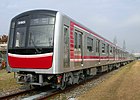Osaka Municipal Subway 66 series
| Osaka Municipal Subway/Osaka Metro 66 series | |
|---|---|
 66611 on a service to Tenchagaya | |
| In service | 1990–present |
| Manufacturer | Kawasaki Heavy Industries, Kinki Sharyo |
| Replaced | 60 series |
| Constructed | 1990–2003 |
| Entered service | 1 August 1990 |
| Refurbished | 2012– |
| Number built | 136 vehicles (17 sets) |
| Number in service | 136 vehicles (17 sets) |
| Formation | 8 cars per trainset |
| Fleet numbers | 66601–66617[citation needed] |
| Operators | Osaka Municipal Subway (1990–2018) Osaka Metro (2018–) |
| Lines served | |
| Specifications | |
| Car body construction | Stainless steel |
| Car length | 18,900 mm (62 ft 0 in) |
| Width | 2,845 mm (9 ft 4.0 in) |
| Height | 4,080 mm (13 ft 5 in) |
| Doors | 3 pairs per side |
| Maximum speed | 70 km/h (43 mph) (Sakaisuji Line) 110 km/h (68 mph) (Hankyu Lines) |
| Traction system | Variable-frequency |
| Traction motors | Squirrel-cage three-phase induction motor |
| Power output | 180 kW (241 hp) |
| Acceleration | 2.8 km/(h⋅s) (1.7 mph/s) |
| Deceleration | 3.5 km/(h⋅s) (2.2 mph/s) (service) 4.0 km/(h⋅s) (2.5 mph/s) (emergency) |
| Electric system(s) | 1,500 V DC overhead wire |
| Current collector(s) | Pantograph |
| Bogies | SS-120 / SS-020 |
| Braking system(s) | Electric commanding brake with regenerative brake |
| Safety system(s) | WS-ATC, Hankyu ATS |
| Track gauge | 1,435 mm (4 ft 8+1⁄2 in) |
The Osaka Municipal Subway/Osaka Metro 66 series (大阪市交通局・大阪メトロ66系) is a rapid transit electric multiple unit (EMU) train type operated by Osaka Municipal Subway in Japan since 1990.[1]
Overview
Seventeen eight-car sets were built to replace the older 60 series sets on the Sakaisuji Line.
The first 12 sets (96 cars) were built in 1990 while an expansion of 40 cars (5 sets) were introduced between 2002 and 2004.[1]
Formations
The Sakaisuji Line fleet consists of 17 eight-car trainsets formed as follows, with car 1 at the Tenchagaya end.
← Tengachaya Tenjimbashisuji 6-chōme → | ||||||||
| Car No. | 1 | 2 | 3 | 4 | 5 | 6 | 7 | 8 |
|---|---|---|---|---|---|---|---|---|
| Designation | Tec1 | Ma1 | Mb1 | Tp' | T' | Mb2 | Ma2 | Tec2 |
| Numbering | 666xx | 660xx | 661xx | 667xx | 668xx | 663xx | 662xx | 669xx |
- The "Ma1" and "Ma2" cars are each fitted with two scissors-type pantographs.
Interior
Passenger accommodation consists of longitudinal seating throughout.
- Interior of a "Tec1" car
- Drivers cabin of "Tec2" car 66908
History
The trains started to undergo refurbishment in 2012. Set 66605 was the first train to be refurbished. It returned to service in February 2013.[2] Works included a new paint scheme, various installations of LED displays and lights, and the installation of a front skirt.
- Refurbished set 66605 in January 2013
References
- ^ a b 堺筋線 66系車両リフレッシュのご紹介 [Introduction of Sakaisuji Line 66 series vehicle refresh] (in Japanese). Osaka Municipal Transportation Bureau. 24 January 2013. Archived from the original on 27 February 2013. Retrieved 25 January 2013.
- ^ “大阪市交66系66605編成が日中試運転 [Osaka Municipal Subway 66 Series 66605 Formation During Daytime Test Run]. railf.jp (in Japanese). 9 January 2013. Retrieved 30 January 2020.




